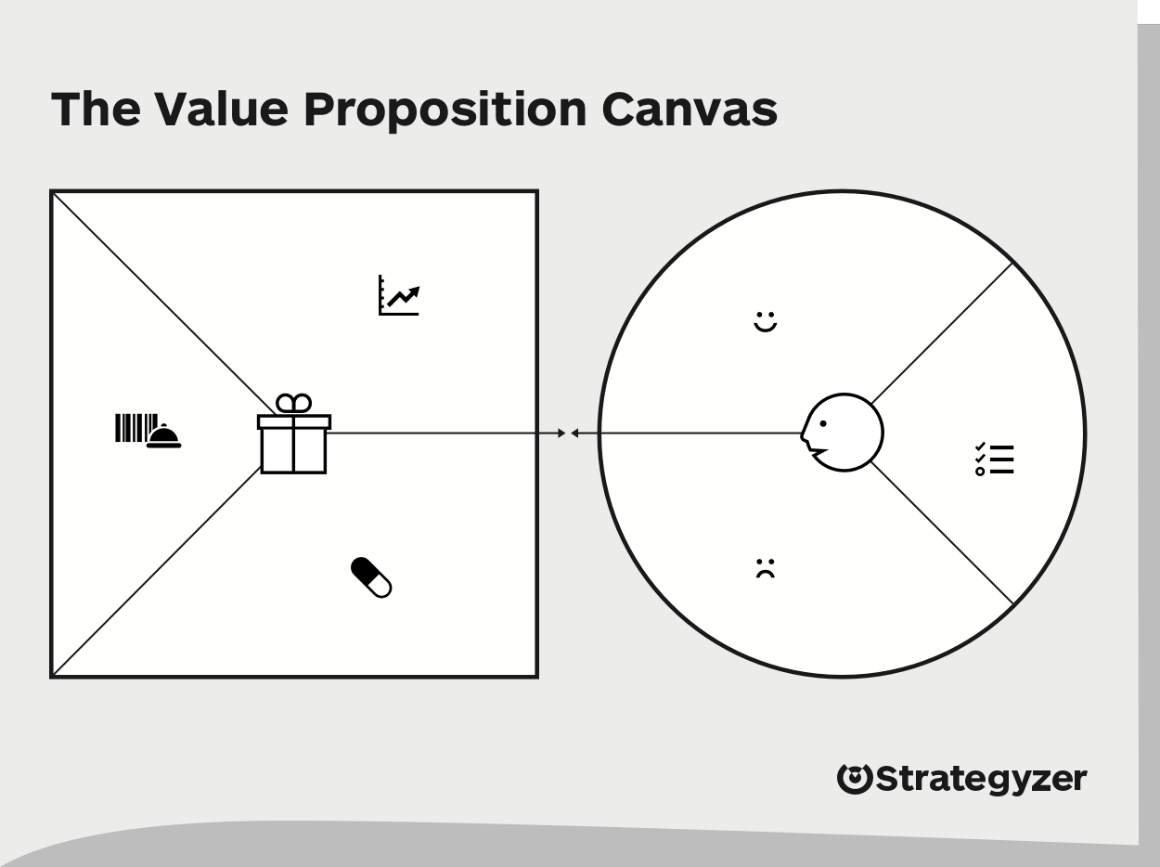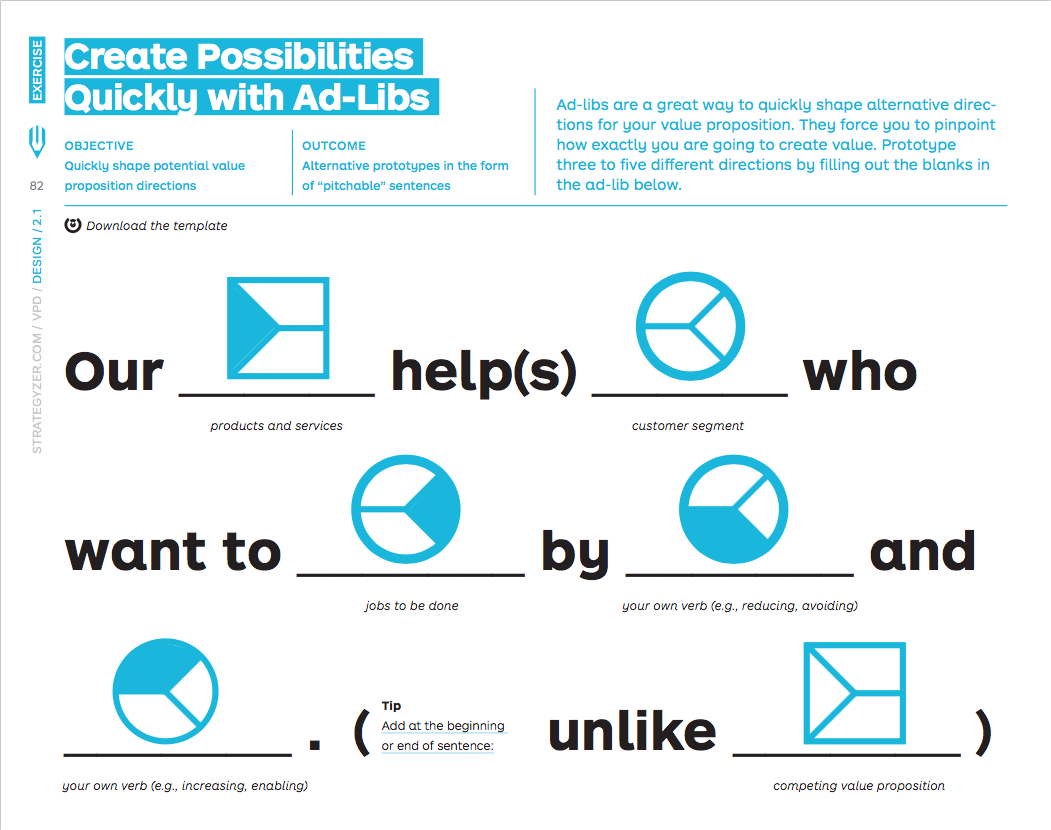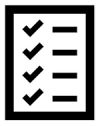Learning Objectives
By the end of this module, you should be able to:
- Understand the different components of the Value proposition Canvas, including the Customer Profile and the Value Map.
- Implement the Value Proposition Canvas for your own startup idea
The Value Proposition Canvas is a tool to help visualize and model a business’ value proposition and customer segments. It takes a much closer look at the Value Propositions and Customer Segments portion of the BMC, as these are arguably the most central parts of the business model. Developing an effective value proposition for a clear customer segment is not an easy task, and many startups fail from not being able to accomplish this. The canvas is pictured below:

The right side of this canvas is called the Customer Profile and the left side of the canvas is called the Value Map. One important consideration of this canvas is that startups can change the Value Map by designing the products and services offered, or by adjusting our channels and the way we communicate the product’s benefits. However, we must discover the Customer Profile through research and testing. The following video will provide another overview of the Value Proposition Canvas, as explained by Alex Osterwalder:
In a book by Alex Osterwalder and other colleagues, the best practices for creating value propositions are covered extensively. There are also many guides online that help with this:
Of course, doing this effectively can take some practice, and requires considerable insight into your customer segments to get right. Some of additional best practices for developing effective value propositions can be found below:
The Best Value Propositions …
- Focus on jobs, pains and gains that are most important to customers (high ranking)
- Focus on unsatisfied jobs, unresolved pains, and unrealized gains
- Target few jobs, pains and gains, but do so extremely well
- Go beyond functional jobs
- Align with how customers measure success
- Focus on jobs, pains, gains that either a lot of people have, or few will pay a lot of money for
- Differentiates jobs, pains, and gains from competition, and outperforms the competition
- Are difficult to copy
Value Map – Best Practices
- List only the products and services that create value for a particular customer segment
- List pain relievers and gain creators as explanations or characteristics make the value of products/services explicit
- Products and services alone don’t create value – it is all relative to customer pains and gains
- Value Propositions are about making choices on which gains and pains you are serving
Customer Profile – Best Practices
- Make a canvas for every customer segment
- Sometimes social or emotional jobs are more important than functional jobs
- “Forget” about what you are offering (do not make the profile with your product in mind)
- The more pains and gains you can identify, the more choice and understanding you have for your value map
- Make pains, gains concrete, and explicit
- Always ask “why” when listing customer jobs
Value Map – Common Mistakes
- Listing ALL products and services, rather than the ones targeted at a specific segment
- Adding products and services to the pain relievers, and gain creators
- Adding pain relievers and gain creators that have nothing to do with pains and gains in the customer profile
- Making an unrealistic attempt to address ALL pains and gains of the customer segment.
Customer Profile – Common Mistakes
- Mixing several customer segments into one profile
- Mixing jobs and outcomes
- Focusing only on functional jobs, and forgetting about social and emotional jobs
- Listing all jobs, pains, gains with value proposition in mind (you do not control these)
- Identifying too few jobs, pains, and gains.
- Being too vague (or not at the “core”) in listing pains, gains, and jobs
Effectively considering the above points will allow you to not only fill out an effective canvas, but also complete what is known as the Value Proposition Ad lib from Staretgyzer.com.

Finding product-market fit is ultimately one of the goals of this course (and for all startups). Product-market fit is when we see alignment between the customer profile and the value map. As stated in “Value Proposition Design” by Alex Osterwalder and colleagues, one achieves fit when customers get excited about your value proposition. This occurs when your business addresses important jobs, alleviates extreme pains, and creates essential gains.
To help find your fit at this point, you will be asked to develop your own value proposition canvas and go through your pain relievers and gain creators one by one. Check to see if they match or fit with a customer pain or gain, and place a check mark next to ones that fit. If a pain reliver or gain creator does not match a pain or gain, this feature may not create value for your customer. If there are too many unmatched pains and gains, you must make sure that your product addresses the most important ones. It is not likely you can address all pains and gains, however the ranking step from the guide in the reading above with help you decide if you have matched the most important ones.
At the end of this section of the course you will be asked whether you have achieved product-market fit for your first iteration. You should constantly go through the exercise in the previous paragraph to review if you are achieving product-market fit.
Supplementary Reading
Osterwalder, A., Pigneur, Y., Bernarda, G. & Smith, A. (2014) Value Proposition Design, John Wiley & Sons.
Supplementary Viewing
Customer Segments are the different groups of people that the business wishes to reach and serve. Simply put, without customers a business will not survive. Startups must make careful decisions about how to group customers into segments, and which of these segments to serve.
For an ATV tour provider, we can choose to serve adventurous tourists to a particular region, or we may also target local organizations looking for a corporate retreat activity. We will consider customer segments in more detail in Section 2 of this course, however the next video provides an overview.

- Let’s now look specifically at your Value Proposition. Follow the steps in this module and come up with a first iteration. You may use a physical copy, or use the Value Proposition template on Stormboard. Now that you’ve considered the Value Proposition in more detail, is it different than what you had originally put in your BMC template from last module? If so, you can also make any necessary adjustments to your BMC as they should both reflect a similar business model.
- After you’ve completed the canvas, try to complete the value proposition ad lib at the end of the module. Remember, all of these things are likely to change.
- Complete the checklist in the product-market fit heading

